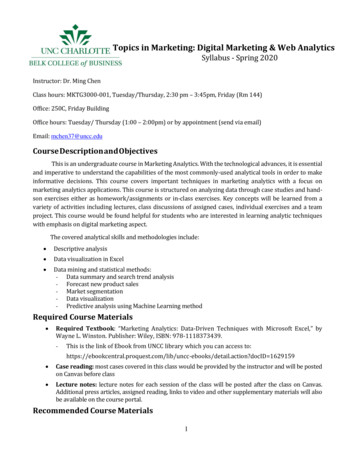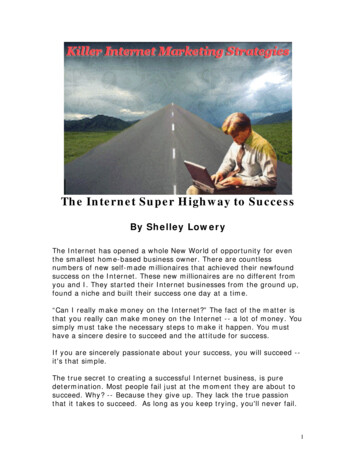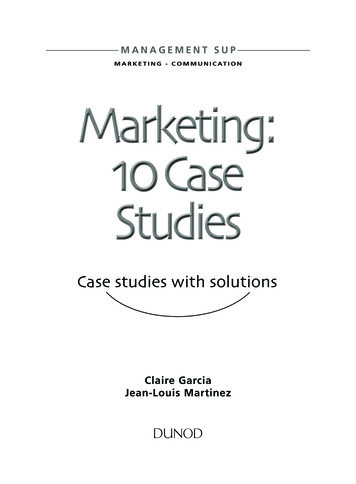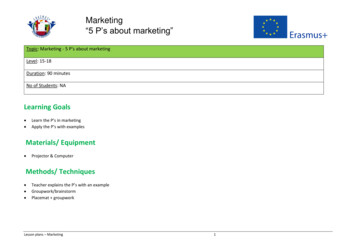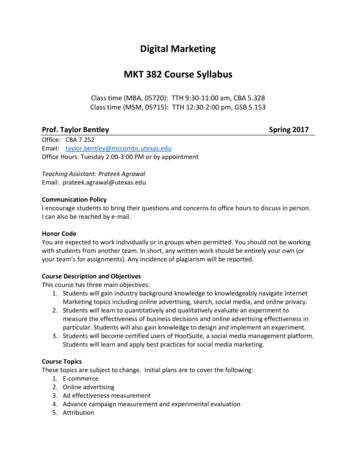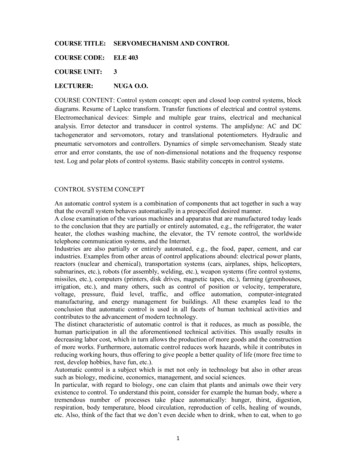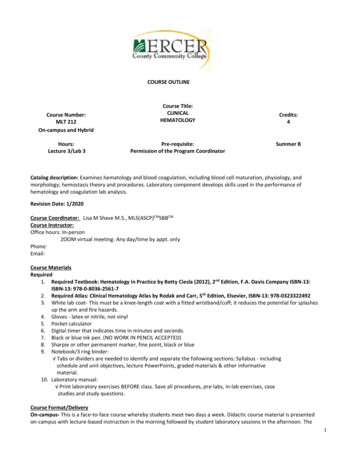
Transcription
Board Approved September 2012Week123456789101112131415161718Unit 1: Marketing is All Around UsUnit 2: The Marketing PlanUnit 4: SellingMarking Period 2Unit 4: SellingUnit 5: Promotion Concepts and StrategiesMid-Term ExamWeekMarking Period 1COURSE: Marketing192021222324252627Marking Period 3Unit 6: DistributionUnit 7: PricingWeekWeekDEPARTMENT: Business Education282930313233343536Marking Period 4Unit 7: PricingUnit 8: Product and Service ManagementFinal Exam
MarketingTime Frame15 DaysTopicMarketing is All Around UsEssential QuestionsWhat is marketing?How is the marketing concept related to the importance of marketing?Why do the functions and foundations of marketing involve multiple business topics and concepts?Why is market segmentation an essential element of marketing?Enduring UnderstandingsAfter the completion of this unit, students will be able to: Define marketing. Identify the seven functions of marketing. Define economic utility. Name the five economic utilities and distinguish those related to marketing. List the benefits of marketing. Discuss the reasons for studying marketing. Describe the trend in future employment opportunities for those trained in marketing. State the marketing concept. Distinguish customers from consumers and explain why the difference is important. Describe what constitutes value for customers and consumers alike. Define what constitutes a market. Suggest two basic ways to identify a business’s potential customers and market products tothem. Describe some of the ways a market can be segmented. Explain how to construct a customer profile. Identify the four P’s of the marketing mix and explain how they are used to reach abusiness’s customers. Define positioning and illustrate its use.Alignment to NJCCCS8.2 Technology Education, Engineering and DesignD. Research and Information FluencyE. Communication and CollaborationF. Resources for a technological worldG. The Designed World9.1 21st Century Life SkillsA. Critical Thinking & Problem SolvingB. Creativity and InnovationC. Collaboration, Teamwork and LeadershipD. Cross-Cultural Understanding and Interpersonal CommunicationsE. Communication and Media Fluency.9.3 21st Career Awareness, Exploration & PreparationA. Career AwarenessB. Career Exploration
MarketingC. Career Preparation9.4.D(2) Business Information Technology9.4.D(3) General Management9.4.D(4) Business Financial Management & Accounting9.4.N(1) Marketing Communications9.4.N(2) Marketing Management9.4.N(3) Marketing Research9.4.N(4) Management & Entrepreneurship9.4.N(5) Merchandising9.4.N(6) Professional Sales & MarketingKey Concepts and SkillsI. Foundations of Marketing Achievement Standard: Recognize the customer-oriented nature of marketing and analyzethe impact of marketing activities on the individual, business, and society.III. External Factors Achievement Standard: Analyze the influence of external factors on marketing.IV. The Marketing Mix Achievement Standard: Analyze the elements of the marketing mix, their interrelationships,and how they are used in the marketing process.V. Marketing Research Achievement Standard: Analyze the role of marketing research in decision making.From the National Standards for Business Education 2007 by the National Business EducationAssociation, 1914 Association Drive, Reston, VA 20191Learning ActivitiesVirtual Business Retailing Modules Risks and Surprises Targeted Marketing Supply and DemandGuided PracticeKey Term ReviewStudent Activity WorkbookStandard & Poor’s Case StudyInternet ActivityDiscussionPowerPoint PresentationCooperative Learning ExerciseGlencoe Virtual Field Trip Business VideosDECA Connection Role Play ActivityChapter 1 of Glencoe Marketing Essentials 2006AssessmentsUnit Comprehensive Online AssessmentCompletion of Virtual Business Retailing Formative AssessmentsPractical Demonstration Formative AssessmentSelf-Assessment Quizzes
MarketingKey Term Quiz21st Century SkillsX CreativityX Critical ThinkingX CommunicationX Life & Career Skills X InformationX Media LiteracyLiteracyInterdisciplinary ConnectionsMathematics, Language Arts, and Social StudiesTechnology IntegrationVirtual Business Retailing Simulation SoftwareGlencoe Online Resource MaterialMS Office SuiteSMART Board ELMO Classroom Visual PresenterSMART Responder XE Interactive Response SystemXCollaboration
MarketingTime Frame15 DaysTopicThe Marketing PlanEssential QuestionsHow do I develop and effective marketing plan for my product or service?Why is a marketing plan an essential element of marketing goods and services?Enduring UnderstandingsAfter the completion of this unit, students will be able to: Explain the communication process used in promotion. Write promotional messages that appeal to target markets. Utilize publicity. Develop a promotional plan. Explain the relationship between customer service and distribution. Select distribution channels and channel members. Determine the need for marketing information. Analyze the environments in which businesses operate. Demonstrate procedures for gathering marketing information technology. Determine pricing objectives, policies, and strategies. Use technology to assist in setting prices. Plan a product/service mix. Analyze product-liability risks. Select materials/products/services to purchase. Describe factors used by marketers to position products/businesses.Alignment to NJCCCS9.1 21st Century Life SkillsA. Critical Thinking & Problem SolvingB. Creativity and InnovationC. Collaboration, Teamwork and LeadershipD. Cross-Cultural Understanding and Interpersonal CommunicationsE. Communication and Media FluencyF. Accountability, Productivity and Ethics9.3 21st Career Awareness, Exploration & PreparationA. Career AwarenessB. Career ExplorationC. Career Preparation9.4.D(1) Administrative Services9.4.D(2) Business Information Technology9.4.D(3) General Management9.4.D(4) Business Financial Management & Accounting9.4.D(5) Human Resources9.4.D(6) Operations Management9.4.J(4) Consumer Service
Marketing9.4.N(1) Marketing Communications9.4.N(2) Marketing Management9.4.N(3) Marketing Research9.4.N(4) Management & Entrepreneurship9.4.N(5) Merchandising9.4.N(6) Professional Sales & MarketingKey Concepts and SkillsI. Foundations of Marketing Achievement Standard: Recognize the customer-oriented nature of marketing and analyzethe impact of marketing activities on the individual, business, and society.II. Consumers and Their Behavior Achievement Standard: Analyze the characteristics, motivations, and behaviors ofconsumers.III. External Factors Achievement Standard: Analyze the influence of external factors on marketing.V. Marketing Research Achievement Standard: Analyze the role of marketing research in decision making.VI. The Marketing Plan Achievement Standard: Describe the elements, design, and purposes of a marketing plan.From the National Standards for Business Education 2007 by the National Business EducationAssociation, 1914 Association Drive, Reston, VA 20191Learning ActivitiesVirtual Business Retailing Modules Market Research Analyzing the Competition Business Plan AnalysisGuided PracticeKey Term ReviewStudent Activity WorkbookStandard & Poor’s Case StudyInternet ActivityDiscussionPowerPoint PresentationCooperative Learning ExerciseGlencoe Virtual Field Trip Business VideosDECA Connection Role Play ActivityChapter 2 of Glencoe Marketing Essentials 2006AssessmentsUnit Comprehensive Online AssessmentCompletion of Virtual Business Retailing Formative AssessmentsPractical Demonstration Formative AssessmentSelf-Assessment QuizzesKey Term QuizMarketing Plan Creation21st Century SkillsX CreativityX Critical ThinkingX CommunicationX Collaboration
MarketingX Life & Career SkillsX Information Literacy X Media LiteracyInterdisciplinary ConnectionsMathematics, Language Arts, and Social StudiesTechnology IntegrationVirtual Business Retailing Simulation SoftwareGlencoe Online Resource MaterialMS Office SuiteSMART Board ELMO Classroom Visual PresenterSMART Responder XE Interactive Response System
MarketingTime Frame25 DaysTopicSellingEssential QuestionsWhat would I need to do to prepare for a sale?How do I initiate the sale?What are the best methods for presenting the product?When is the proper time to close the sale?Why is it important to ensure customer satisfaction and retention?Enduring UnderstandingsAfter the completion of this unit, students will be able to: Define selling and state its goals. Explain feature-benefit selling. Identify sources of product information. Discuss how customers make buying decisions. Explain how selling skills can be helpful in careers other than sales. Distinguish different types of sales positions. Identify the characteristics of effective salespeople. List the eight steps of a sale. Explain how salespeople find customers. Describe how the preapproach is used in industrial and retail sales. Explain the importance and purposes of the approach in the sales process. Describe how industrial sales representatives conduct the initial approach. List the three approach methods retail salespeople use and state when it is appropriate to useeach. Explain why determining needs is an essential step in the sales process. Describe three methods used for determining needs. State the goal of the product presentation. Explain how products are selected for the presentation. Describe what to say during the product presentation. Identify four techniques that will make for a lively and effective product presentation. Distinguish between objections and excuses. Explain why objections should be welcomed in the sales process. Identify the five buying decisions upon which common objections are based. List the four steps involved in handling customer objections. Identify six specific methods of handling objections. Demonstrate the use of those methods in a variety of selling situations. Recognize customer buying signals. List the rules for closing a sale. Demonstrate specialized methods of closing a sale. Explain why suggestion selling is important. List the rules for effective suggestion selling. Demonstrate specialized suggestion selling methods. Discuss the concept of relationship marketing and how it is related to the sales process.Alignment to NJCCCS9.1 21st Century Life Skills
MarketingA. Critical Thinking & Problem SolvingB. Creativity and InnovationC. Collaboration, Teamwork and LeadershipD. Cross-Cultural Understanding and Interpersonal CommunicationsE. Communication and Media FluencyF. Accountability, Productivity and Ethics9.3 21st Career Awareness, Exploration & PreparationA. Career AwarenessB. Career ExplorationC. Career Preparation9.4.J(4) Consumer Service9.4.N(6) Professional Sales & MarketingKey Concepts and SkillsI. Foundations of Marketing Achievement Standard: Recognize the customer-oriented nature of marketing and analyzethe impact of marketing activities on the individual, business, and society.II. Consumers and Their Behavior Achievement Standard: Analyze the characteristics, motivations, and behaviors ofconsumers.III. External Factors Achievement Standard: Analyze the influence of external factors on marketing.V. Marketing Research Achievement Standard: Analyze the role of marketing research in decision making.From the National Standards for Business Education 2007 by the National Business EducationAssociation, 1914 Association Drive, Reston, VA 20191Learning ActivitiesVirtual Business Retailing Modules Staffing TurnaroundGuided PracticeKey Term ReviewStudent Activity WorkbookStandard & Poor’s Case StudyInternet ActivityDiscussionPowerPoint PresentationCooperative Learning ExerciseGlencoe Virtual Field Trip Business VideosDECA Connection Role Play ActivityChapters 12, 13, 14 & 15 of Glencoe Marketing Essentials 2006AssessmentsUnit Comprehensive Online AssessmentCompletion of Virtual Business Retailing Formative Assessments
MarketingPractical Demonstration Formative AssessmentSelf-Assessment QuizzesKey Term Quiz21st Century SkillsX CreativityX Critical ThinkingX CommunicationX Life & Career Skills X Information Literacy X Media LiteracyInterdisciplinary ConnectionsMathematics, Language Arts, and Social StudiesTechnology IntegrationVirtual Business Retailing Simulation SoftwareGlencoe Online Resource MaterialMS Office SuiteSMART Board ELMO Classroom Visual PresenterSMART Responder XE Interactive Response SystemX Collaboration
MarketingTime Frame30 DaysTopicPromotional Concepts and StrategiesEssential QuestionsHow do promotion and the promotional mix help firms to sell products and services?What are the types of promotion and how are they utilized in marketing?How do I utilize design features in visual merchandising?Is artistic design helpful in reaching my target market?When I utilize advertising media how I measure my media usage and calculate media rates?What are the essential elements of advertising?What is the most effective advertising layout?Enduring UnderstandingsAfter the completion of this unit, students will be able to: Explain the promotional mix concept and its role in marketing. Explain the role of promotion as a marketing function. Identify the elements of the promotional mix. Discuss trade and consumer sales promotions. Develop sales promotion plans. Analyze the use of specialty promotion. Explain the nature and scope of public relations. Write a news release. Develop public relations plan. Analyze costs/benefits of company participation in community activities. Obtain publicity. Discuss the elements of visual merchandising and the artistic aspects of creating a display. Explain the use of visual merchandising. Explain the use of visual merchandising to create an image. Explain the types of display arrangements. Explain the relationship of merchandising and visual merchandising (display). Prepare merchandise for display. Maintain displays. Explain the purpose and importance of advertising. Identify the different types of advertising media. Explain the types of advertising media. Evaluate the effectiveness of advertising. Calculate media costs. Select advertising media. Prepare print advertising. Explain the use of advertising agencies. Explain the components of advertisements. Describe the use of technology in the promotion function. Demonstrate appropriate creativity.Alignment to NJCCCS8.2 Technology Education, Engineering and DesignD. Research and Information FluencyE. Communication and Collaboration
MarketingF. Resources for a technological worldG. The Designed World9.1 21st Century Life SkillsA. Critical Thinking & Problem SolvingB. Creativity and InnovationC. Collaboration, Teamwork and LeadershipD. Cross-Cultural Understanding and Interpersonal CommunicationsE. Communication and Media FluencyF. Accountability, Productivity and Ethics9.3 21st Career Awareness, Exploration & PreparationA. Career AwarenessB. Career ExplorationC. Career Preparation9.4.C(1) Audio & Visual Technology and Film9.4.C(2) Journalism and Broadcasting9.4.C(3) Printing Technology9.4.C(6) Visual Arts9.4.N(1) Marketing Communications9.4.N(2) Marketing Management9.4.N(3) Marketing Research9.4.N(6) Professional Sales & MarketingKey Concepts and SkillsI. Foundations of Marketing Achievement Standard: Recognize the customer-oriented nature of marketing and analyzethe impact of marketing activities on the individual, business, and society.II. Consumers and Their Behavior Achievement Standard: Analyze the characteristics, motivations, and behaviors ofconsumers.III. External Factors Achievement Standard: Analyze the influence of external factors on marketing.V. Marketing Research Achievement Standard: Analyze the role of marketing research in decision making.From the National Standards for Business Education 2007 by the National Business EducationAssociation, 1914 Association Drive, Reston, VA 20191Learning ActivitiesVirtual Business Retailing Modules Promotion Advanced Promotion Analyzing the CompetitionGuided PracticeKey Term ReviewStudent Activity Workbook
MarketingStandard & Poor’s Case StudyInternet ActivityDiscussionPowerPoint PresentationCooperative Learning ExerciseGlencoe Virtual Field Trip Business VideosDECA Connection Role Play ActivityChapters 17, 18, 19 & 20 of Glencoe Marketing Essentials 2006AssessmentsUnit Comprehensive Online AssessmentCompletion of Virtual Business Retailing Formative AssessmentsPractical Demonstration Formative AssessmentSelf-Assessment QuizzesKey Term Quiz21st Century SkillsX CreativityX Critical ThinkingX CommunicationX Life & Career Skills X Information Literacy X Media LiteracyInterdisciplinary ConnectionsMathematics, Language Arts, and Social StudiesTechnology IntegrationVirtual Business Retailing Simulation SoftwareGlencoe Online Resource MaterialMS Office SuiteSMART Board ELMO Classroom Visual PresenterSMART Responder XE Interactive Response SystemX Collaboration
MarketingTime Frame25 DaysTopicDistributionEssential QuestionsWhy is distribution and distribution planning an essential element of marketing?What are the best methods for transporting products?How do I effectively store and account for inventory?Who is the buyer?What is the purpose of the purchasing function?Is the stock handling process part of distribution?Why is inventory control an essential part of distribution planning?Enduring UnderstandingsAfter the completion of this unit, students will be able to: Select the appropriate channels of distribution to effectively sell consumer and industrialproducts. Explain the nature of channels of distribution. Explain the nature of channel members’ relationships. Explain the nature and scope of distribution. Explain the nature of channel strategies. Select channels of distribution. Explain the nature and scope of transportation systems and services. Explain the shipping process. Explain storing considerations. Explain the nature of warehousing. Explain marketing and its importance in a global economy. Distinguish between purchasing agents and buyers. Describe the buying process and the effect the Internet has had on the purchasing function. Calculate the major entries in a merchandise plan. Explain the nature and scope of purchasing. Plan purchases. Explain the nature of the buying process. Conduct vendor search. Explain the stock handling process. Figure stock turnover rates. Discuss the nature and the impact of technology on inventory management and inventorysystems. Explain the receiving process. Explain stock handling techniques used in receiving deliveries. Explain the nature of inventory control systems. Explain the types of inventory control systems.Alignment to NJCCCS8.2 Technology Education, Engineering and DesignE. Communication and CollaborationF. Resources for a technological worldG. The Designed World
Marketing9.1 21st Century Life SkillsA. Critical Thinking & Problem SolvingB. Creativity and InnovationC. Collaboration, Teamwork and LeadershipD. Cross-Cultural Understanding and Interpersonal CommunicationsE. Communication and Media FluencyF. Accountability, Productivity and Ethics9.3 21st Career Awareness, Exploration & PreparationA. Career AwarenessB. Career ExplorationC. Career Preparation9.4.D(1) Administrative Services9.4.D(2) Business Information Technology9.4.D(3) General Management9.4.D(4) Business Financial Management & Accounting9.4.D(5) Human Resources9.4.D(6) Operations Management9.4.N(1) Marketing Communications9.4.N(2) Marketing Management9.4.N(4) Management & Entrepreneurship9.4.N(5) Merchandising9.4.N(6) Professional Sales & Marketing9.4.P Transportation, Distribution & Logistics Career Cluster9.4.P(1) Transportation Operations9.4.P(2) Logistics Planning and Management9.4.P(3) Warehousing and Distribution Center Operations9.4.P(4) Planning Implementation9.4.P(5) Transportation Systems/Infrastructure Planning, Management, and Regulations9.4.P(6) Health, Safety, and Environmental Management9.4.P(7) Sales and ServiceKey Concepts and SkillsI. Foundations of Marketing Achievement Standard: Recognize the customer-oriented nature of marketing and analyzethe impact of marketing activities on the individual, business, and society.III. External Factors Achievement Standard: Analyze the influence of external factors on marketing.From the National Standards for Business Education 2007 by the National Business EducationAssociation, 1914 Association Drive, Reston, VA 20191Learning ActivitiesVirtual Business Retailing Modules
Marketing Merchandising Security Advanced MerchandisingGuided PracticeKey Term ReviewStudent Activity WorkbookStandard & Poor’s Case StudyInternet ActivityDiscussionPowerPoint PresentationCooperative Learning ExerciseGlencoe Virtual Field Trip Business VideosDECA Connection Role Play ActivityChapters 22, 23 & 24 of Glencoe Marketing Essentials 2006AssessmentsUnit Comprehensive Online AssessmentCompletion of Virtual Business Retailing Formative AssessmentsPractical Demonstration Formative AssessmentSelf-Assessment QuizzesKey Term Quiz21st Century SkillsX CreativityX Critical ThinkingX CommunicationX Life & Career Skills X Information Literacy X Media LiteracyInterdisciplinary ConnectionsMathematics, Language Arts, and Social StudiesTechnology IntegrationVirtual Business Retailing Simulation SoftwareGlencoe Online Resource MaterialMS Office SuiteSMART Board ELMO Classroom Visual PresenterSMART Responder XE Interactive Response SystemX Collaboration
MarketingTime Frame30 DaysTopicPricingEssential QuestionsWhat are the price planning considerations?What are the factors involved in price planning?Do I need basic pricing policies?How can I effectively utilize strategies in the pricing process?Is there a specific way to calculate prices?Enduring UnderstandingsAfter the completion of this unit, students will be able to:1. Explain the nature and scope of price planning.2. Explain factors affecting pricing decisions.3. Discuss the legal considerations of pricing.4. Explain the nature and scope of the pricing function.5. Select approach for setting a base price.6. Determine cost of product (break-even, ROI, markup, price).7. Calculate break-even point.8. Describe pricing concepts and policies for products in various stages of the life cycle.9. Use pricing terminology and techniques correctly and effectively.10. Explain the principles of supply and demand.11. Identify strategies for pricing new products.12. Determine cost of product.13. Select approach for setting a base price.14. Set prices.15. Use pricing math to calculate markups and markdowns.16. Plan and implement a pricing strategy.17. Describe the nature of profit and loss statements.18. Determine discounts and allowances that can be used to adjust base prices.Alignment to NJCCCS9.1 21st Century Life SkillsA. Critical Thinking & Problem SolvingB. Creativity and InnovationC. Collaboration, Teamwork and LeadershipD. Cross-Cultural Understanding and Interpersonal CommunicationsE. Communication and Media FluencyF. Accountability, Productivity and Ethics9.3 21st Career Awareness, Exploration & PreparationA. Career AwarenessB. Career ExplorationC. Career Preparation9.4.D(4) Business Financial Management & Accounting9.4.N(1) Marketing Communications9.4.N(2) Marketing Management
Marketing9.4.N(3) Marketing Research9.4.N(4) Management & Entrepreneurship9.4.N(5) Merchandising9.4.N(6) Professional Sales & MarketingKey Concepts and SkillsI. Foundations of Marketing Achievement Standard: Recognize the customer-oriented nature of marketing and analyzethe impact of marketing activities on the individual, business, and society.II. Consumers and Their Behavior Achievement Standard: Analyze the characteristics, motivations, and behaviors ofconsumers.III. External Factors Achievement Standard: Analyze the influence of external factors on marketing.V. Marketing Research Achievement Standard: Analyze the role of marketing research in decision making.From the National Standards for Business Education 2007 by the National Business EducationAssociation, 1914 Association Drive, Reston, VA 20191Learning ActivitiesVirtual Business Retailing Modules Pricing Financial StatementsGuided PracticeKey Term ReviewStudent Activity WorkbookStandard & Poor’s Case StudyInternet ActivityDiscussionPowerPoint PresentationCooperative Learning ExerciseGlencoe Virtual Field Trip Business VideosDECA Connection Role Play ActivityChapters 25, 26 & 27 of Glencoe Marketing Essentials 2006AssessmentsUnit Comprehensive Online AssessmentCompletion of Virtual Business Retailing Formative AssessmentsPractical Demonstration Formative AssessmentSelf-Assessment QuizzesKey Term Quiz21st Century SkillsX CreativityX Critical ThinkingX CommunicationX CollaborationX Life & Career Skills X Information Literacy X Media LiteracyInterdisciplinary ConnectionsMathematics, Language Arts, and Social StudiesTechnology IntegrationVirtual Business Retailing Simulation SoftwareGlencoe Online Resource Material
MarketingMS Office SuiteSMART Board ELMO Classroom Visual PresenterSMART Responder XE Interactive Response System
MarketingTime Frame30 DaysTopicProduct and Service ManagementEssential QuestionsWhat is the difference between product planning, mix, and development?How can I sustain product sales?What are the branding elements and strategies?Is packaging and labeling important to marketing a product?Why should I offer warranties and credit to my customers?Enduring UnderstandingsAfter the completion of this unit, students will be able to: Explain how businesses plan what products to produce and sell and how they position andmange these products. Explain the nature and scope of product planning, product mix, and product development. Explain the concept of a product life cycle. Identify strategies to position products in various life cycles. Explain the nature and scope of the product/service management function. Explain the concept of product mix. Plan product mix. Identify the impact of product life cycles on marketing decisions. Describe factors used by marketers to position products/businesses. Explain the nature and scope of branding, packaging, and labeling in product planning. Identify the importance branding, branding elements, and branding strategies to product/servicemanagement. Explain the nature of branding. Explain branding strategies. Explain the functions of packaging. Explain labeling laws. Explain the importance of warranties and credit to product planning. Discuss the importance of warranties as extended product features. Explain warranties and guarantees. Identify consumer protection provisions of appropriate agencies. Explain the purpose and importance of credit. Obtain the purposes and importance of obtaining credit (business). Describe legal issues affecting businesses.Alignment to NJCCCS9.1 21st Century Life SkillsA. Critical Thinking & Problem SolvingB. Creativity and InnovationC. Collaboration, Teamwork and LeadershipD. Cross-Cultural Understanding and Interpersonal CommunicationsE. Communication and Media FluencyF. Accountability, Productivity and Ethics9.3 21st Career Awareness, Exploration & PreparationA. Career Awareness
MarketingB. Career ExplorationC. Career Preparation9.4.D(6) Operations Management9.4.J(4) Consumer Service9.4.M(1) Manufacturing Production Process Development9.4.M(2) Production9.4.M(3) Maintenance, Installation, and Repair9.4.M(4) Quality Assurance9.4.M(5) Logistics and Inventory Control9.4.M(6) Health, Safety, and Environmental Assurance9.4.N(1) Marketing Communications9.4.N(2) Marketing Management9.4.N(3) Marketing Research9.4.N(5) Merchandising9.4.N(6) Professional Sales & MarketingKey Concepts and SkillsI. Foundations of Marketing Achievement Standard: Recognize the customer-oriented nature of marketing and analyzethe impact of marketing activities on the individual, business, and society.II. Consumers and Their Behavior Achievement Standard: Analyze the characteristics, motivations, and behaviors ofconsumers.III. External Factors Achievement Standard: Analyze the influence of external factors on marketing.V. Marketing Research Achievement Standard: Analyze the role of marketing research in decision making.From the National Standards for Business Education 2007 by the National Business EducationAssociation, 1914 Association Drive, Reston, VA 20191Learning ActivitiesVirtual Business Retailing Modules PurchasingGuided PracticeKey Term ReviewStudent Activity WorkbookStandard & Poor’s Case StudyInternet ActivityDiscussionPowerPoint PresentationCooperative Learning ExerciseGlencoe Virtual Field Trip Business VideosDECA Connection Role Play ActivityChapters 30, 31 & 32 of Glencoe Marketing Essentials 2006
MarketingAssessmentsUnit Comprehensive Online AssessmentCompletion of Virtual Business Retailing Formative AssessmentsPractical Demonstration Formative AssessmentSelf-Assessment QuizzesKey Term Quiz21st Century SkillsX CreativityX Critical ThinkingX CommunicationX Life & Career Skills X Information Literacy X Media LiteracyInterdisciplinary ConnectionsMathematics, Language Arts, and Social StudiesTechnology IntegrationVirtual Business Retailing Simulation SoftwareGlencoe Online Resource MaterialMS Office SuiteSMART Board ELMO Classroom Visual PresenterSMART Responder XE Interactive Response SystemX Collaboration
DEPARTMENT: Business Education COURSE: Marketing . Week Marking Period 1 Week Marking Period 3 1 Unit 1: Marketing is All Around Us 19 Unit 6: Distribution 2 20 3 21 4 Unit 2: The Marketing Pl



